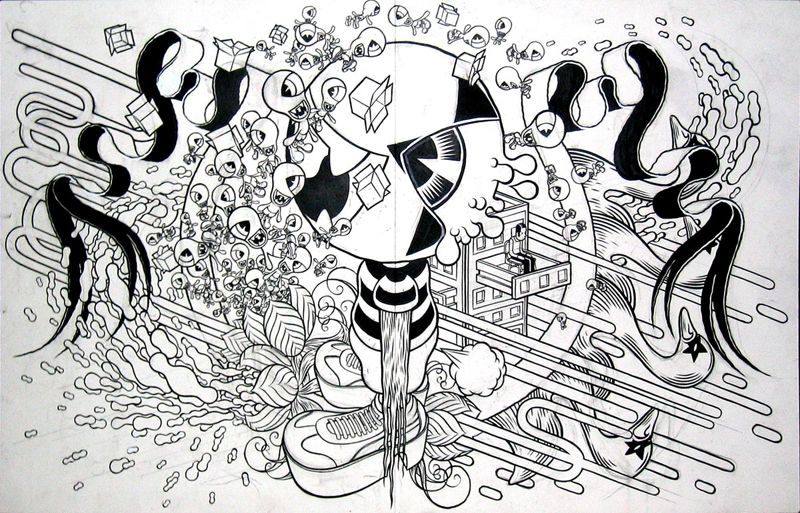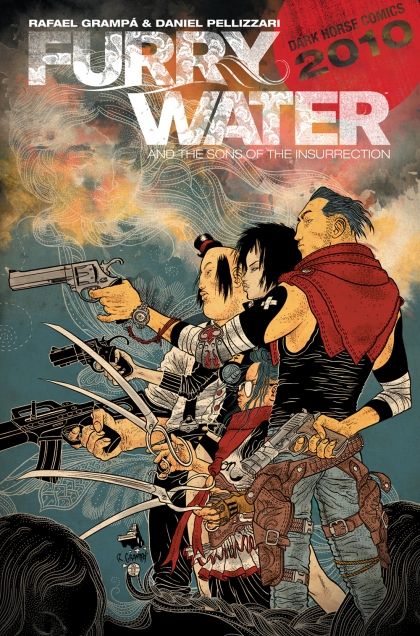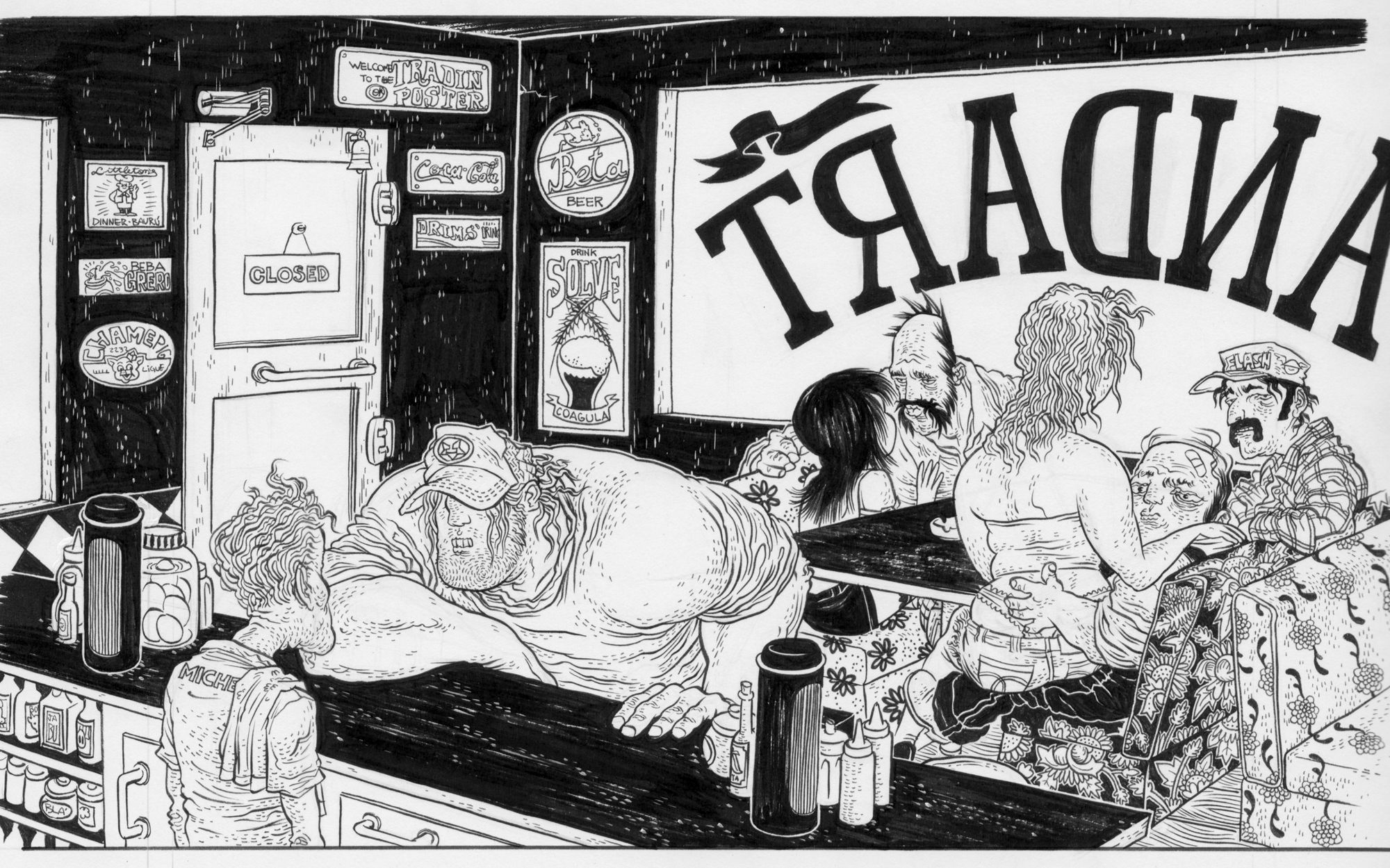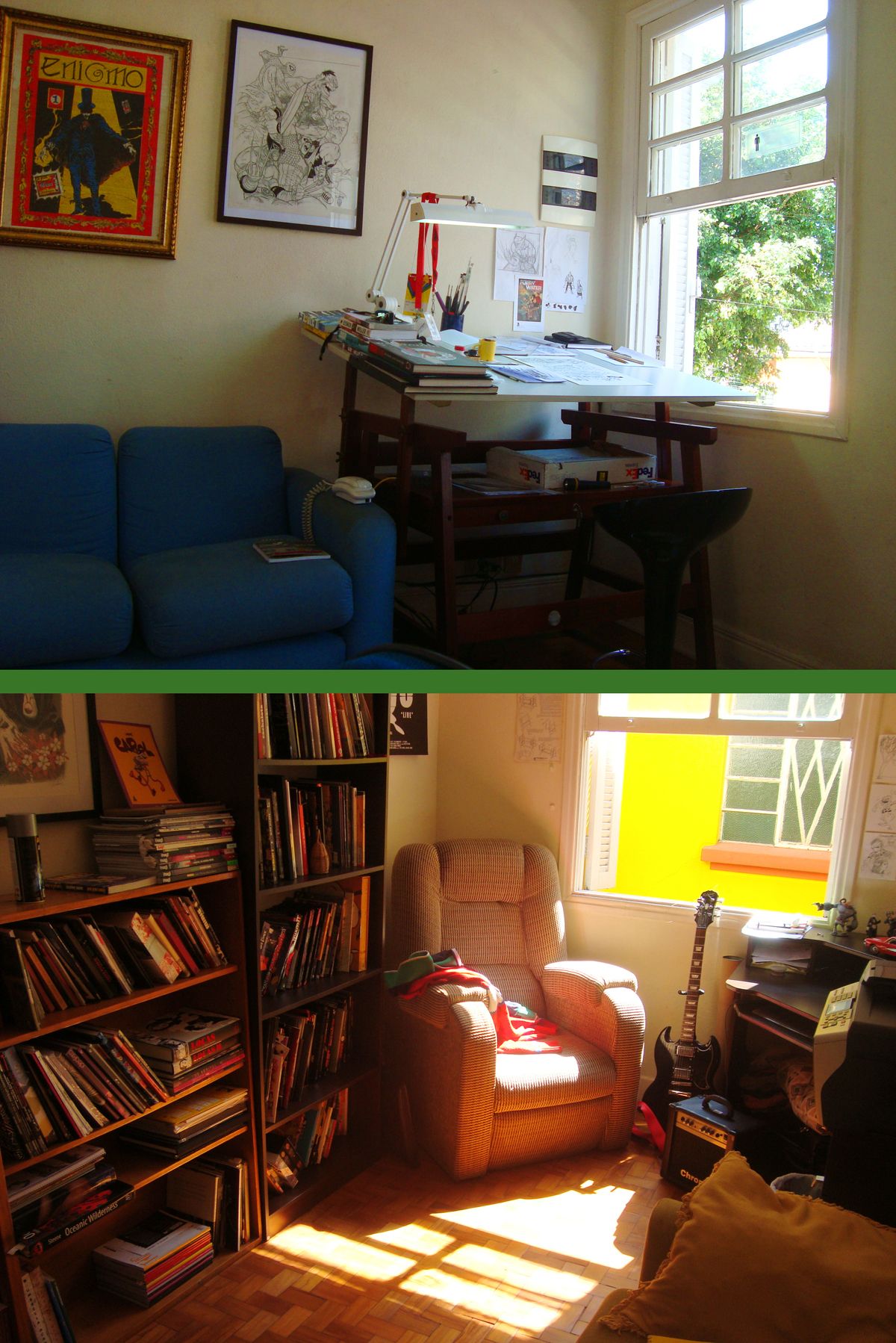The artist Rafael Grampá first came to my attention through Gunned Down, a 2005 small-press anthology of Western stories done largely by South American creators. Joining him were then-unknowns Fábio Moon and Gabriel Bá. Although the book didn't sell well, flipping through it I realized I was holding something special. Moon and Bá rose to fame pretty quickly with works at AiT-PlanetLar, their self-published projects, and comics at Dark Horse and Vertigo. But Grampá's work was few and far between.
With the release of the anthology 5 in 2007 and his first solo work Mesmo Delivery in 2008, American comics audiences got their first real taste of what Grampá could do. Vertigo hired him to contribute to a milestone issue of Hellblazer; Marvel, with a milestone issue of Daredevil; Dark Horse reprinted the sold-out Mesmo Delivery, which goes for over $125 new at Amazon. Recently Marvel put him as the lead feature in the second volume of Strange Tales, and Dark Horse contracted him for his second standalone graphic novel.
His work evokes easy comparisons to Geoff Darrow, but deeper analysis shows an appreciation for detail, not for detail's sake, but to add flavor and weight to the scene he depicts in a panel, a pin-up or a cover. Rather than just drawing to tell you where someone is and what they're doing, Rafael's illustrative line adds texture, tone, mood and atmosphere -- and that's before a colorist touches the page. Although well-known by some in the industry, by and large the mainstream comics public doesn't know the full scope of what the artist is -- or could be. Maybe this interview will help.
Chris Arrant: Hey, Rafael – let’s start with an easy one, what are you working on today?
Rafael Grampá: Hey, Chris, nice to talk with you again. Now I'm still working on Furry Water & the Sons of the Insurrection. I said still because I'm working on it since 2009. During this period, I've been working very slowly on it because of some adjustments on the project and, at the same time, trying to reorganize my life. We'd announced the project to release in 2010 but we decided to get more time to make Furry Water, and we're looking forward to releasing it for next year. The most exciting thing about having all this time to produce the series is that all of our crazy and megalomaniac scenes and ideas will be in the project. Furry Water, this post-Apocalyptic saga, is set 70 years after the "Furry Water" plague hit. Against this backdrop, we meet the Nobunagas, a family of outlaws who have a family obligation to re-start the insurrection against an "optimist-oppressive" regime. At the same time, four brothers and a sister are searching for the fifth "lost" brother, who may or may not exist. It's a violent poetry about brotherhood, honor and faith.
Arrant: Can you tell us particular about the page you’re working on today, or if you’re jumping around to multiple pages, or what not?
Grampá: Sure. I'm working on an action scene that a militia is trying to enter inside the dirty hospital room where the Nobunagas are crying because of their matriarch's death. It's a very difficult scene because I'm working with a camera movement in a corridor, traveling out, and I'm showing the reaction of all the soldiers. I want some really human feelings here, like bold and fear. I won't tell what happens after, but the sequence is totally awesome! And if you know my work, you can imagine how much details it would have.
Arrant: Before you became so embroiled with comics I read you had a graphic design job. Do you still do that, and can you tell us about your work before comics?
Grampá: Yes, I used to be a concept designer and director of motion graphics, but I don't do it anymore. Today I'm just a comic book creator, and I thing it is an amazing upgrade in my career. Even if I wanted, couldn't work with another thing because the way I want to do comics requires a lot of dedication and I couldn't share it with any other media right now. Comics are the most difficult and fun thing that I’ve ever done, and it's enough for now. Matt Fraction used to work at a motion graphic studio as well, writing the script for the animations, and we already collaborated on a job together during this period, like 2005. I love to have this motion graphics and design background and it is very important on work in comics today.
Arrant: What was the one big thing that made you jump from the job of concept designer/motion graphics director into the freelance work of comic art? Was it one job, or a big gig, or what?
Grampá: The big thing was that I always wanted to be a comic book creator to tell my own stories, and I was not making this at the motion graphic studio that I used to work. I realized that I was just working for another guy's dream, not mine. So I decided to leave my job and start my first comic book, which was Mesmo Delivery. I saved some money and I self-published the first 2,000 copies of Mesmo Delivery, with the distribution of AdHouse Books. It was very expensive for me, but it was an investment on my own dream. And it worked!
Arrant: The first time I saw your work was on a short strip in Terra Major’s Gunned Down anthology from years and years ago. Do you have any other early comics work out there that people may not know about?
Grampá: That short story for the Gunned Down anthology was my first pages as a comic book creator.
OK, maybe I did a little bit of other stuff. ... I did some test pages for superheroes comics that I never sent to anybody, and already worked on a short story for a Brazilian small press that made kids comics, in the '90s, but I don't consider it as my own comics. Also, in the '90s, I tried to create my own characters but I did just some comic strips and single pages and never published it. So, Gunned Down's pages were my really first publication as a comic book creator. Before the launch of Mesmo Delivery I also made the anthology 5 and because of that I have an Eisner Award here at my studio.
Arrant: For an American like me, your heavily detailed work reminds me of Geof Darrow and some classic BD illustrators – but I’m probably missing a whole range of influences. How did your style develop into what it is today?
Grampá: When somebody just discovers my work it is very normal to compare it with Geof Darrow's. And, yes, it happens a lot more in the USA because you are very familiar with his work. It is a great honor for me, I love Darrow's work; it's totally amazing. I will never do the awesome things that he does, but I have to say that he is not this huge influence for my work, not like the way people thinks he is. I always obsess over details -- even in my early design and freelance illustration works, before I became a cartoonist. If you mix this obsession with Walt Disney, E. C. Segar, Angeli e Laerte (two very well-known and amazing Brazilian cartoonists), Moebius, R. Crumb, Jeff Smith, Jamie Hewlett, Katsuhiro Otomo, Patrice Killoffer and so many other artists, designers, musicians and movie directors that influence my day, you will have me.
Arrant: Since you jumped into the scene, both Marvel and DC have taken notice of you – and you’ve done pieces for DC’s Hellblazer, Marvel’s Daredevil and you did the cover and story to the second Strange Tales anthology from Marvel. Were these superhero comics a big part of your adolescence. If not, what do you consider your favorite comics?
Grampá: I was crazy about superheroes when I was a kid, for sure. In my adolescence I discovered awesome Brazilian cartoonists like Angeli and Laerte e Glauco, who influenced me a lot. At the same period I discovered Moebius, Liberatore, Max, Katsuhiro Otomo and a lot of other Japanese and European artists that influence me even to this day.
When Marvel invited me to do that Daredevil pin up, I didn’t expect that the fans would dig it as much as they did. Daredevil was one of my preferred characters when I was a teen, like the characters I re-designed for the Strange Tales cover, and it was really amazing to put my vision on those characters. The original art of Strange Tales is already on my wall, to celebrate the first time I drew the characters that turned my childhood into magic. About the story I've made to the Strange Tales 2 anthology, it is the main story of Vol.2, a love tale with a lot of wrestling violence starring Wolverine. I also wrote the script and I hope the fans like it as I like it.
Arrant: Right now you’re working on Furry Water, but do you have any other projects on the periphery?
Grampá: I already have another project after Furry Water but I'll start it just when I get Furry Water done, of course. It's a horror graphic novel, a story that I've wanted to tell since 2001. My girl fell in love with me when I told her this story. It's also a love story, and she’s been with me since I told it to her, so I believe it's a really great story [laughs]. But only now do I have the skills that the story needs to do it right.





